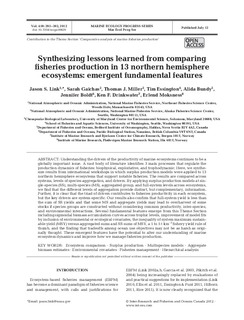| dc.description.abstract | Understanding the drivers of the productivity of marine ecosystems continues to be a
globally important issue. A vast body of literature identifies 3 main processes that regulate the
production dynamics of fisheries: biophysical, exploitative, and trophodynamic. Here, we synthesize
results from international workshops in which surplus production models were applied to 13
northern hemisphere ecosystems that support notable fisheries. The results are compared across
systems, levels of species aggregation, and drivers. By applying surplus production models at single-
species (SS), multi-species (MS), aggregated group, and full-system levels across ecosystems,
we find that the different levels of aggregation provide distinct, but complementary, information.
Further, it is clear that the triad of drivers contributes to fisheries productivity in each ecosystem,
but the key drivers are system-specific. Our results also confirm that full-system yield is less than
the sum of SS yields and that some MS and aggregate yields may lead to overharvest of some
stocks if species groups are constructed without considering common productivity, inter-species,
and en vironmental interactions. Several fundamental features emerge from this Theme Section
including sigmoidal biomass accumulation curves across trophic levels, improvement of model fits
by inclusion of environmental or ecological covariates, the inequality of system maximum sustainable
yield (MSY) versus aggregated sums and SS sums of MSY, a 1 to 5 t km−2 fishery yield rule of
thumb, and the finding that tradeoffs among ocean use objectives may not be as harsh as originally
thought. These emergent features have the potential to alter our understanding of marine
ecosystem dynamics and improve how we manage fisheries production. | no_NO |
